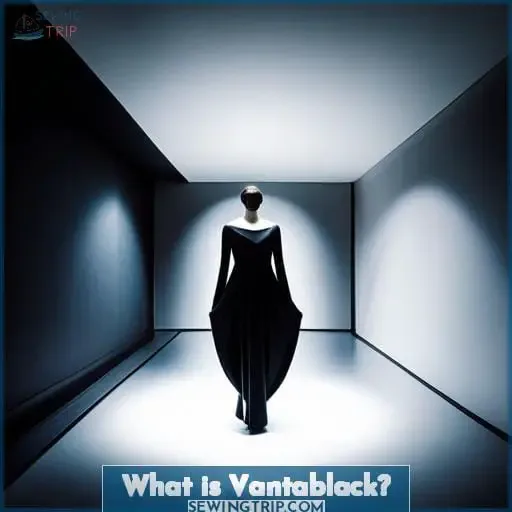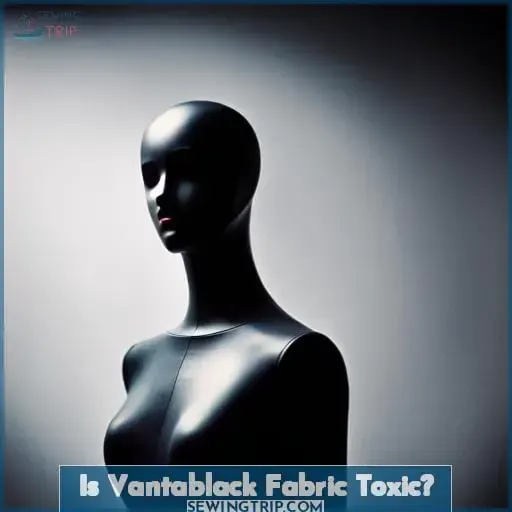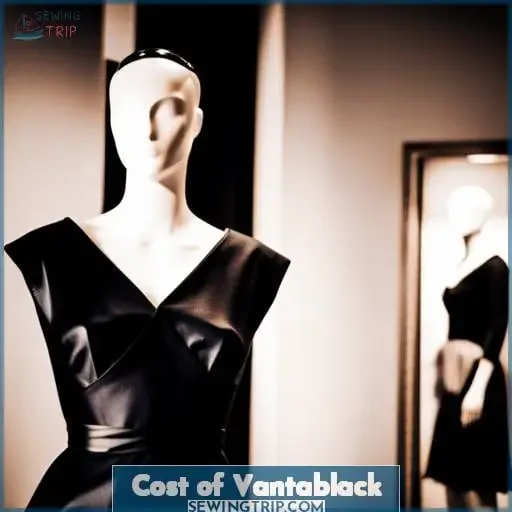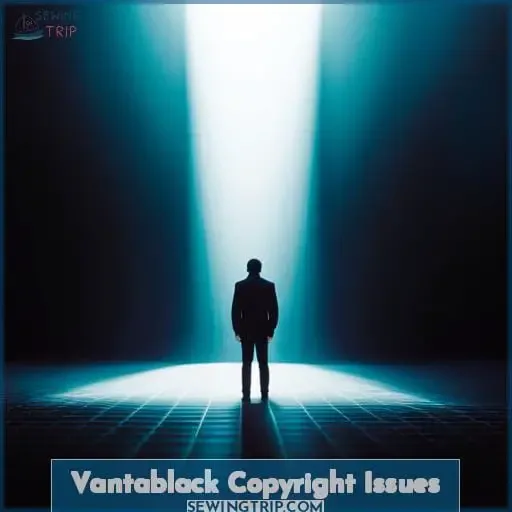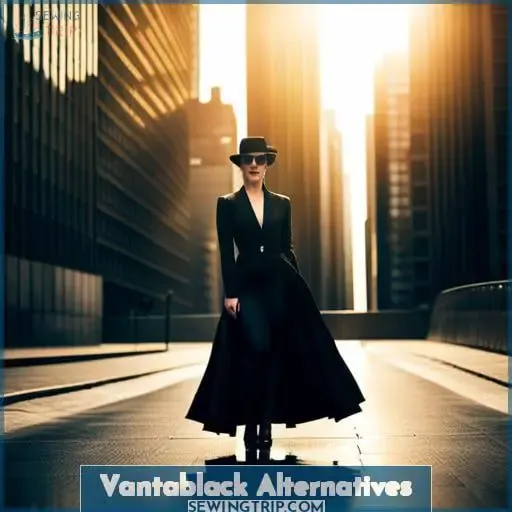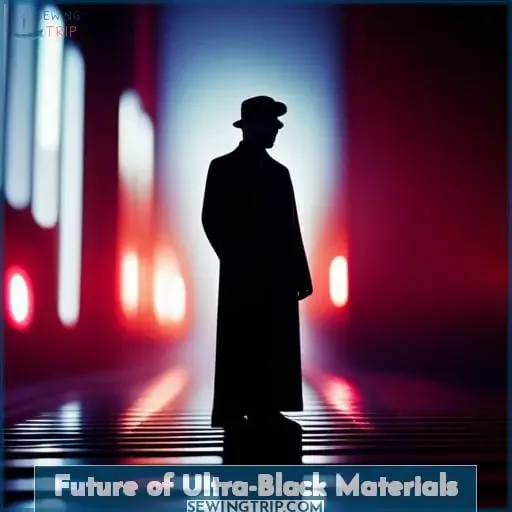This site is supported by our readers. We may earn a commission, at no cost to you, if you purchase through links.
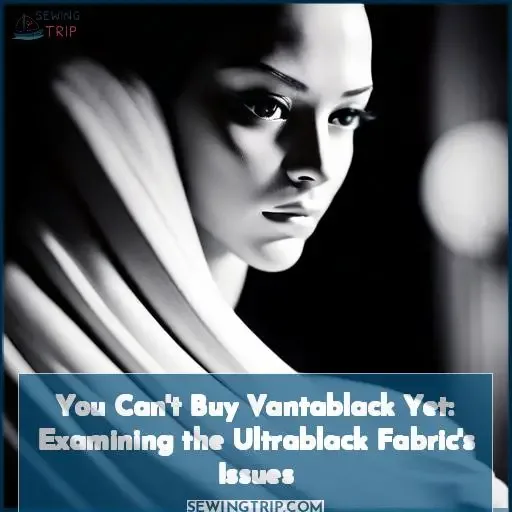
Vantablack’s carbon nanotube forest absorbs over 99% of visible light, creating an eye-catching void.
However, this seemingly mystical material remains elusive, with usage constrained by practicality.
Its fragility precludes integration into garments, thwarting your subconscious desire for innovation’s leading edge.
But while you can’t buy Vantablack clothes currently, alternatives emerge tapping that craving for the unobtainable.
Progress marches on.
Table Of Contents
Key Takeaways
- Vantablack’s exclusive licensing limits broader commercial applications.
- Creating Vantablack fabric poses major technical challenges.
- Alternatives offer high light absorption for fashion and art.
- Costs stay extremely high due to exclusivity and complexity.
What is Vantablack?
You’re looking at the blackest black ever created when you see Vantablack, a groundbreaking substance that absorbs a staggering 99.
This revolutionary material, composed of vertically aligned carbon nanotubes, has captivated the worlds of science, art, and fashion alike.
While its applications span a wide range of industries, from military to aerospace, its unique properties and exclusivity have also sparked debates surrounding safety, legality, and accessibility.
Delving into the enigmatic realm of Vantablack, we’ll uncover its captivating allure and the challenges it poses, leaving you with a deeper understanding of this extraordinary material.
Can You Buy Vantablack Clothing?
Preventing you from purchasing Vantablack clothing currently is the exclusive rights held by artist Anish Kapoor.
His legal claim over the use of Vantablack limits your ability to buy it, as he hasn’t authorized any commercial production.
Even if you could find a way around his exclusive rights, creating clothing with Vantablack poses significant technical hurdles related to the fragility of the nanotubes that give it its ultrablack properties.
Attempts so far have been unsuccessful at adapting it for fabric use without compromising its delicate structure.
For now, the best alternatives are more robust ultrablack materials like S139 Suede Black paint or Black 3.
Though not quite as dark, these allow you to experiment with an ultrablack look without the legal and health implications of true Vantablack.
The future may hold new formulations better suited for clothing, but exclusive rights issues persist around this technology.
Is Vantablack Fabric Toxic?
One must take precautions when working with Vantablack fabric, as prolonged exposure can irritate your skin, eyes, and lungs.
Safety measures like protective gear are essential when handling this specialized material, given health risks shown in toxicology studies.
Guidelines indicate limiting contact, but data on safe exposure times remain unclear for humans.
Though composed of widely used ingredients like carbon, the vacuum deposition process makes Vantablack uniquely hazardous by bonding materials at the nanoscale.
Complex legal and ethical issues around distributing such a potent substance underscore why average consumers can’t simply buy bolts of this ultrablack fabric yet.
We must thoughtfully navigate innovations that promise great potential but require great responsibility.
Cost of Vantablack
You’d be hard-pressed to buy Vantablack due to its extraordinarily high cost stemming from the exclusivity rights limiting its availability and challenging production process.
The pricing complexities of this ultrablack fabric are influenced by various technical cost factors, making it economically unviable for widespread commercial use.
Here’s why:
- Exclusivity challenges: Exclusive rights held by artist Anish Kapoor prevent the mass production and sale of Vantablack products, including clothing, paint, and even cars.
- Limited availability: The unique properties of Vantablack make it difficult to produce in large quantities efficiently, further driving up costs.
- Technical complexity: Creating Vantablack involves a precise manufacturing process that requires specialized equipment and expertise, adding to the already high expenses associated with producing this exceptional material.
With such considerations in mind, obtaining a piece of Vantablack remains an elusive dream for most individuals seeking artistic purposes or simply fascinated by its unparalleled light absorption capabilities.
Vantablack Copyright Issues
Unfortunately, the artist Anish Kapoor secured exclusive rights to Vantablack’s use in art, limiting your ability to utilize its unique properties without facing potential legal issues.
As an innovator desiring control over his creation, Kapoor likely believed restricting Vantablack’s use was necessary to protect his artistic vision.
However, limiting its application prevents others from exploring Vantablack’s potential.
Seeking compromise may enable broader access while still respecting Kapoor’s rights.
For example, licensing Vantablack’s use for non-art purposes could allow further research.
Overall, balancing exclusive rights against innovation is complex, especially for groundbreaking technologies.
With thoughtful dialogue, win-win solutions benefitting all parties may emerge.
Still, Vantablack’s exclusivity fuels debate over ownership of ideas versus the greater good.
The quest continues for ultrablack fabrics not subject to such constraints.
Vantablack Health Concerns
Exposure to Vantablack brings up questions around its safety for you, with studies showing potentially concerning effects for prolonged contact.
- Chemical composition irritates skin, eyes, and lungs leading to discomfort and potential health issues over time.
- Excessive exposure causes sensory deprivation from light absorption properties.
- Must take proper safety precautions like protective gear to minimize health risks when working with it.
Vantablack Alternatives
While Vantablack’s exclusive rights prevent commercial use, you’ll find promising substitutes.
Black 3.0 offers 98% light absorption at a reasonable cost.
Or consider Stuart Semple’s paints, like Black 2n0.
And S139 Suede Black provides a paintable ultra-matte coating with a velvety texture for creative applications.
Black 3.0
After the health concerns of Vantablack, you’d love Stuart Semple’s Black 3.0 as a safer alternative.
This affordable, paintable acrylic allows unleashing artistic innovations and scientific advancements through DIY applications.
By democratizing access to ultrablack materials, Black 3.0’s cultural impact sparks desires for progress, transcending commercial viability.
Imagine new artistic mediums and scientific discoveries enabled when ultrablack paint empowers people’s creative freedom.
S139 Suede Black
You’re looking for a Vantablack alternative that retains a deep black appearance without the associated risks and availability issues.
S139 Suede Black offers a paintable coating with a texture resembling suede that absorbs up to 99% of visible light for a fraction of Vantablack’s cost and hassle.
Adapting this specialized coating for artistic and commercial use provides an accessible ultrablack material without Vantablack’s fragility or legal constraints.
Future of Ultra-Black Materials
As Vantablack’s mystique grows despite its unavailability, even blacker materials loom on the horizon.
- NanoTube Innovations like vertically-grown forests and graphene promise increased light absorption.
- DIY Nanotube Brewing kits and recipes shared online push the boundaries of accessibility.
- Blackest Artistry Trends utilize emerging techniques to manifest the deepest voids captured in paint, sculpture, and photography.
- Vantablack Evolution from its early restrictive use toward diverse commercial availability seems inevitable despite exclusivity deals.
- Homemade UltraBlack concoctions hint at the limitless creativity unleashed when anyone can access the darkest materials imaginable.
The future of ultrablack belongs to us all.
Frequently Asked Questions (FAQs)
What are the best uses for Vantablack in fashion? Since the material is delicate, what garments or accessories would be the most practical applications?
Given Vantablack’s fragility, opt for small accessories like belts or jewelry.
Its delicate nature suits soft fabrics like silk scarves.
Let the material shine by keeping designs minimal.
Focus on its light-absorbing properties.
Is it illegal to make DIY versions of Vantablack at home? What are the legal loopholes around using similar carbon nanotube materials?
You may create similar nanotube materials at home, but selling or sharing risks legal issues.
Focus creative energy on novel techniques within the public domain.
True innovation arises from imagination unbound.
How did Anish Kapoor secure exclusive rights to Vantablack? What was the process and criteria for licensing the material to a single artist?
Surrey Nanosystems awarded exclusive rights to Kapoor, motivated by security over intellectual property.
Yet, such constraints on a color contradict creativity’s demand for freedom.
Innovators find inspiration in the shadows, moving ever deeper into the vast unknown.
Has anyone successfully created Vantablack clothing without permission? Have there been attempts by other designers to bypass Kapoor’s exclusive rights?
You’re right to wonder.
Though Kapoor’s rights limit use, some designers still experiment with nanotubes.
However, successfully mimicking Vantablack’s properties at scale remains an elusive goal.
True breakthroughs require patience and creativity to navigate constraints.
We eagerly await inspired innovation that enlightens.
What are the most promising alternatives to Vantablack for fashion use? Which newer light-absorbing materials seem closest to achieving the same ultra-black effect?
You grasp at straws.
The ultra-black effect remains elusive, though promising.
Seek Musou Black for the deepest black.
Yet, limitations abound.
Innovate beyond known shades.
Freedom awaits discovery.
The impossible proves possible in time’s fullness.
Persevere.
Conclusion
Thou yearnest for the unobtainable ultrablack, yet practicality precludes it.
But fret not! Alternatives emerge, tapping thy cravings whilst progress marches on.
Can’t buy Vantablack clothes currently? Fret not!
Blacker-than-black textiles cometh, evoking the mystical material’s allure.
Patience; innovation leads ever onward.
Take heart that one day, options shall abound for integrating this technology into thy raiment.
The future unfurls with promise.

